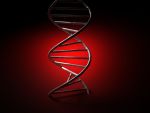EPJ E Highlight - DNA’s double stranded stretch
- Details
- Published on 27 October 2012

Models simulate what happens to DNA strands when stretched to the breaking point
Theoretical physicists like to play with very unconventional toys. Manoel Manghi from Toulouse University in France and his colleagues have adopted a seemingly playful approach to examining what happens to a double stranded molecule of DNA when it is stretched to the breaking point, in a study about to be published in EPJ E. Instead of using optical tweezers to stretch DNA as previously done in experimental settings, the authors focused on using a theoretical model to account for the structural deformations of DNA and determine how its mechanical characteristics could explain certain biological processes.
Over fifteen years ago, scientists discovered that DNA undergoes two structural transitions when pulled from both ends. The problem is that in experimental conditions these two transitions can overlap and can therefore be difficult to observe. Instead, Manghi and colleagues relied on a standard mathematical tool referred to as a ‘coupled discrete wormlike chain-Ising model’ to simulate DNA stretching and match experimental observations.
Thanks to their theoretical approach, the authors confirmed that after overcoming initial resistance to stretching, at a force of around 65 piconewtons (pN) in strength, the DNA stretches to almost twice its original length while also becoming less rigid. They also confirmed the other known structural transition occurring at around 135 pN. Although the critical forces of both transitions depend on the DNA sequence, they found it is the second one that most depends on it.
Beyond 135pN, DNA strands start peeling apart into single stranded DNAs that are similar to those obtained when DNA is heated up and undergoes thermal denaturation. This model thus bridges the gap between force-induced mechanical stretching and thermal denaturation and could potentially help understand how DNA performs its biological functions such as interaction with proteins and how it is packaged, say, in viruses.
Mesoscopic models for DNA stretching under force: new results and comparison to experiments. M. Manghi, N. Destainville, J. Palmeri (2012), European Physical Journal E 35:110, DOI: 10.1140/epje/i2012-12110-2




